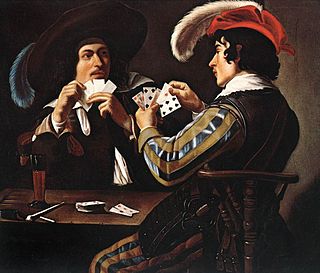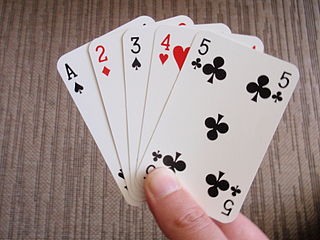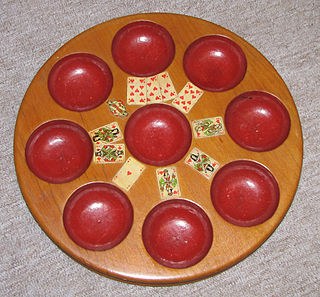Related Research Articles

A card game is any game that uses playing cards as the primary device with which the game is played, whether the cards are of a traditional design or specifically created for the game (proprietary). Countless card games exist, including families of related games. A small number of card games played with traditional decks have formally standardized rules with international tournaments being held, but most are folk games whose rules may vary by region, culture, location or from circle to circle.

A playing card is a piece of specially prepared card stock, heavy paper, thin cardboard, plastic-coated paper, cotton-paper blend, or thin plastic that is marked with distinguishing motifs. Often the front (face) and back of each card has a finish to make handling easier. They are most commonly used for playing card games, and are also used in magic tricks, cardistry, card throwing, and card houses; cards may also be collected. Playing cards are typically palm-sized for convenient handling, and usually are sold together in a set as a deck of cards or pack of cards.

Tarot is a pack of playing cards, used from at least the mid-15th century in various parts of Europe to play card games such as Tarocchini. From their Italian roots, tarot-playing cards spread to most of Europe, evolving into a family of games that includes German Grosstarok and modern games such as French Tarot and Austrian Königrufen. In the late 18th century French occultists made elaborate, but unsubstantiated, claims about their history and meaning, leading to the emergence of custom decks for use in divination via tarot card reading and cartomancy. Thus, there are two distinct types of tarot packs in circulation: those used for card games and those used for divination. However, some older patterns, such as the Tarot de Marseille, originally intended for playing card games, are occasionally used for cartomancy.

Baccarat or baccara is a card game played at casinos. It is a comparing card game played between two hands, the "player" and the "banker". Each baccarat coup has three possible outcomes: "player", "banker", and "tie".

Ombre or l'Hombre is a fast-moving seventeenth-century trick-taking card game for three players and "the most successful card game ever invented."
Pagat.com is a website containing rules to hundreds of card games from all over the world. Maintained by John McLeod, it contains information for traditional, commercial, and newly invented card games from all over the world. It has been described by writer David Parlett as the most important site of its kind on the Internet and the "only authoritative web site for all rules of card games and associated material."
Ruff and Honours, Ruffe and Trump or Slamm was an English trick-taking card game that was popular in the 16th and 17th centuries; it was superseded in the 18th century by Whist.
The history of contract bridge may be dated from the early 16th-century invention of trick-taking games such as whist. Bridge departed from whist with the creation of Biritch in the 19th century, and evolved through the late 19th and early 20th centuries to form the present game.

Brelan is a famous French vying game with rapidly escalating bets from the seventeenth to nineteenth century, and hence also a name for a card player, gambler or the name of the place where the game was played. The game is quite similar to the game of Bouillotte, but it is not played anymore.

Trappola is an early 16th-century Venetian trick-taking card game which spread to most parts of Central Europe and survived, in various forms and under various names like Trapulka, Bulka and Hundertspiel until perhaps the middle of the 20th century. It was played with a special pack of Italian-suited cards and last reported to have been manufactured in Prague in 1944. Piatnik has reprinted their old Trappola deck for collectors.
The International Playing-Card Society (IPCS) is a non-profit organisation for those interested in playing cards, their design, and their history. While many of its members are collectors of playing cards, they also include historians of playing cards and their uses, particularly card games and their history.
The International Board Game Studies Association (IBGSA) is an academic professional association "devoted to the history and development of board games throughout the world". The IBGSA sponsors an annual scholarly conference, the BGSA Colloquium, as well as an academic peer-reviewed journal, Board Game Studies. The IBGSA's membership includes academics, museum curators, game designers, archivists, and collectors.

Poch, Pochen or Pochspiel is a very old card game that is considered one of the forerunners of poker, a game that developed in America in the 19th century. An etymological relationship between the game names is also assumed. Games related to Poch are the French Glic and Nain Jaune and the English Pope Joan. Other forerunners of poker and possible relatives of the game are the English game, Brag, from the 16th century and the French Brelan and Belle, Flux et Trente-et-Un. Poch is recorded as early as 1441 in Strasbourg. In north Germany it was called by the Low German name of Puchen or Puchspill, and the board was a Puchbrett.

An ace–ten game is a type of card game, highly popular in Europe, in which the aces and tens are of particularly high value.

Bräus is an old Swedish card game from the island of Gotland that differs from all others in that not all cards are actually playable. The game is descended from the oldest known card game in Europe, Karnöffel, a fact testified by its unusual card ranking and lack of a uniform trump suit.

Twenty-one, formerly known as vingt-un in Britain, France and America, is the name given to a family of popular card games of the gambling family, the progenitor of which is recorded in Spain in the early 17th century. The family includes the casino games of blackjack and pontoon as well as their domestic equivalents. Twenty-one rose to prominence in France in the 18th century and spread from there to Germany and Britain from whence it crossed to America. Known initially as vingt-un in all those countries, it developed into pontoon in Britain after the First World War and blackjack in Canada and the United States in the late 19th century, where the legalisation of gambling increased its popularity.

Mouche, also known as Lanterlu, is an old, French, trick-taking card game for two to six players which has elements, such as bluffing, reminiscent of the much later game of poker. It is a member of the Rams family of games and, although it is a gambling game, often played for small stakes, it is also suitable as a party game or as a family game with children from the age of 12 upwards. It is named after the mouche, a term that variously refers to its winning hand, the basic stake and the penalty for failing to take any tricks. Although also called Bête, it should not be confused with the older game of that name from which it came and which, in turn, was a derivative of Triomphe.
John McLeod is a British mathematician, author, historian and card game researcher who is particularly well known for his work on tarot games as well as his reference website pagat.com which contains the rules for over 500 card games worldwide. He is described as a "prominent member" of the International Playing Card Society and is Secretary of the British Skat Association.

Black Maria is a popular British card game of the Hearts group for three to six players. It is an elaboration of Black Lady, itself a development of the original American game of Hearts, the progenitor of the group. Black Maria is regarded as one of the best games for three players.
Thierry Depaulis is an independent historian of games and especially of playing cards, card games, and board games. He is President of the association Le Vieux Papier, a member of the editorial board of the International Board Game Studies Association, and a member of the board of directors of the foundation of the Swiss Museum of Games. He was President of the International Playing-Card Society from 2017 to 2022.
References
- ↑ Parlett (2008), p. xi.
- ↑ "Combined Index of IPCS Publications 1972-1997". 1999.
- ↑ "The Journal of the International Playing-Card Society".
- ↑ Parlett (2008), p. 151.
- ↑ Parlett (2008), p. 149.
- ↑ Depaulis, Thierry (2010). "Dawson’s Game: Blackjack and the Klondike," in The Playing-Card, Journal of the International Playing-Card Society, Vol. 38, No. 4, ed. by Peter Endebrock, April–June 2010, 317 pages. Published by The International Playing-Card Society, ISSN 0305-2133.
- ↑ The volume and issue numbers of the journal are shown in brackets below.